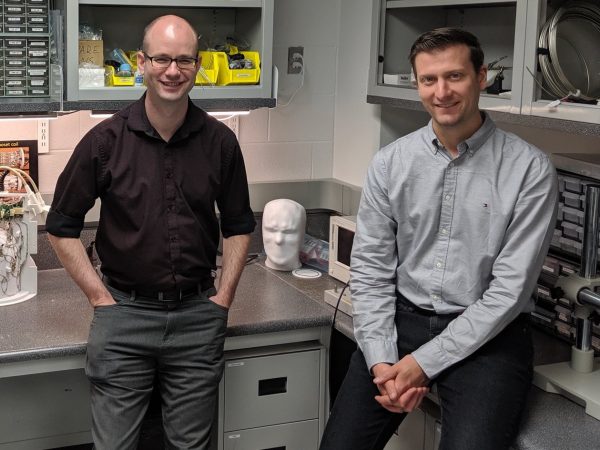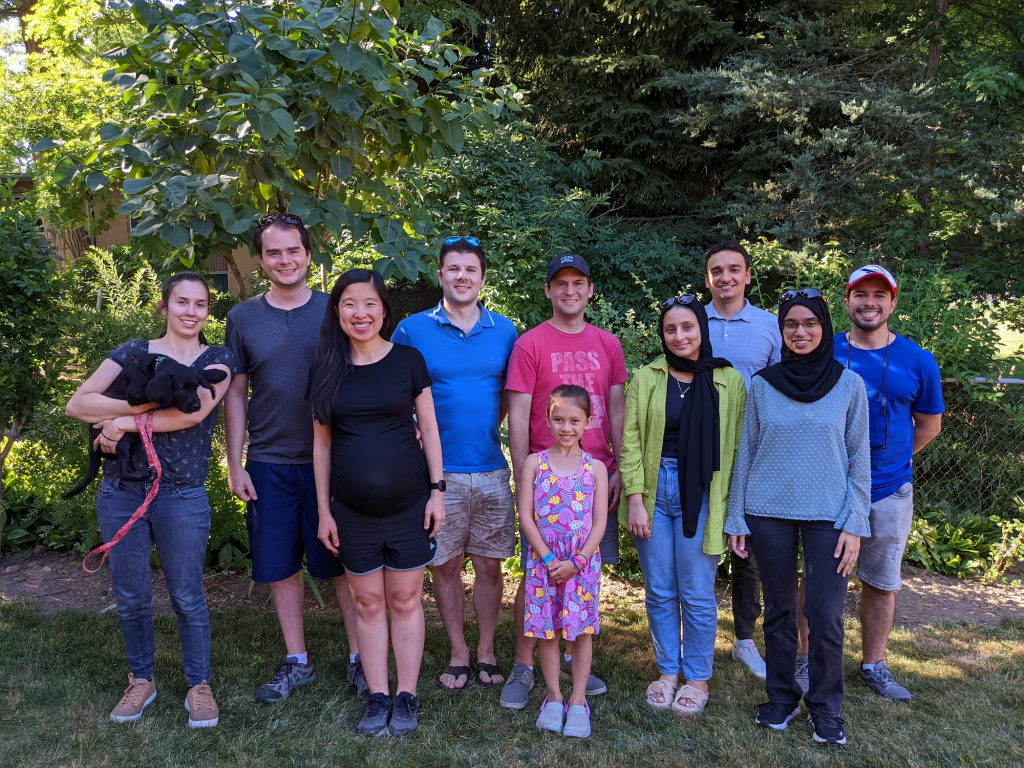By Mathieu Boudreau

This MRM Highlights Pick interview is with Kyle Gilbert and Corey Baron, researchers at the Centre for Functional and Metabolic Mapping (CFMM) at Western University in London, Ontario. Their paper is entitled “Integration of an RF coil and commercial field camera for ultrahigh-field MRI”. It was chosen because of the exemplary reproducible research practices implemented by the authors, who shared their coil design CAD file and performance files and their image reconstruction code.
To discuss this Q&A, please visit our Discourse forum.
MRMH: Tell us about yourselves and how you first became interested in MR?
Kyle: I grew up in Vancouver and attended my undergrad at UBC in the Department of Physics. I came to Western in 2003 to attend grad school and did my PhD in physics in Blaine Chronik’s lab, working on MR hardware. Afterwards, I stayed in London and joined the Centre for Functional and Metabolic Mapping (CFMM) where I did a postdoc and became a research scientist, which is my current position.
Corey: I’m somewhat of a farm kid – I grew up on a farm in northern Alberta. I went to the University of Alberta for my undergrad in engineering physics. I went on to receive an MSc in Electrical Engineering where I did research involving laser physics, which was interesting, but after that I wanted to do something I felt would have more of an impact on people. So, I joined Christian Beaulieu’s lab at U of A to do a PhD working in MRI, and I then did my postdoc at Stanford in Dwight Nishimura’s lab. I’m now an assistant professor at Western University here in London.
MRMH: Before we jump into your paper, could you explain what a field camera is in this context and how it works?

Corey: Basically, when we do MRI scanning, there are many unwanted magnetic fields present. When you want to use more sophisticated k-space trajectories during your acquisitions, like the single-shot spiral diffusion sequence used in our paper, it’s really important to know how all these extra fields are behaving due to things like eddy currents, breathing motions, etc. The purpose of the field probe system is to directly measure, in real time, all these extra fields that are normally ignored. This information is then used in the image reconstruction process to remove artifacts from these fields. As for the way this field camera works, it’s composed of a series of probes connected to a dedicated spectrometer. Each probe consists of a small solenoid with a sample of fluorine inside. When a pulse sequence trigger is sent, typically just prior to the k-space readout, a simple hard pulse is applied to the fluorine samples and the free-induction decay (FID) signal from the probes is acquired. The phase of the FIDs measured by the field probes can then be used to determine field changes during the k-space readout. This process is repeated for every k-space readout in the scan, which results in characterization of field changes for the entire scan.
MRMH: Thanks! Could you give us an overview of the paper?
Kyle: Although field cameras are not very widely used right now, they are becoming increasingly popular and so there are commercial systems available. We purchased our field cameras from a company called Skope, which offers several solutions for 3T and 7T. For 7T, they offer what are called clip-on cameras, where the probes can be affixed on top of your coil. But here at Western, our 7T magnet is actually a head-only magnet, one of the few of this kind in the world, and so we also have a head-only gradient in the bore. Because of this, we have to build all our own RF coils for our 7T system, and therefore the clip-on cameras don’t fit on top of our current coils. This paper presents our solution for getting around this problem, which was to design an RF coil, integrating these field probes inside of it right from the design stage. This gave us a lot of freedom to optimize the whole system. Another main goal of this project was to improve workflow, which hopefully will encourage more users to use the system. We looked at the performance of the coil with and without the integrated field probes, and found there was very little difference overall on both sides (coil and field camera). And in particular, the transmit coil performance wasn’t affected much, which is really important from the perspective of SAR and safety concerns at high field using parallel transmit systems. The FIDs of the field probes did have slightly shorter lifetimes because some of them are positioned in the nonlinear region of the gradients, but Corey and his grad student Paul Dubovan have been working diligently on some correction algorithms, which have substantially improved the image quality.
MRMH: Did you expect your coil-camera setup to perform as well as it did?
Kyle: Were we surprised? I would say yes. I was surprised that we could add 16 different field probes with 16 cables in such a tight space, and that with proper positioning it would end up having very little effect on the RF transmitter and receiver – I was a little shocked by that. And I was pleasantly surprised at how little it actually affected the field probes. I think at the beginning, I was more worried about the impact on the RF coils. I honestly thought the transmit field was going to be a disaster, that we would have a very difficult time trying to get a uniform transmit field after integrating so many peripheral devices inside the transmit coil. Luckily, I was wrong on that, and the setup performed beyond my expectations.

Corey: I was also pleasantly surprised, but not for the same reasons as Kyle. Because the linear region of the gradients is only a 20-centimeter diameter region around the isocenter, some of the field probes had to be placed outside that region; some of them were up to 12 centimeters away from the isocenter – right on the edge of where the linear region transitions to non-linear. But when you do the fits for the field changes that we’ve now developed, even though the probes are in fact in that nonlinear region, you can still reconstruct the k-space trajectory and eddy current dynamics accurately.
MRMH: You shared some code, coil performance files, and a CAD file for your hardware design with your paper. What were your intentions in sharing these with the MRI community?
Corey: Overall, whenever possible we tried to put our material online for others to use. The software that Paul and I developed that performs custom image reconstructions using the field probe data is publically available, for example.
Kyle: For a few years now, I would say, we have been making a concerted effort to make our work publicly available, as much as we possibly can. I think that encourages reproducibility. And also, because we’re publicly funded, we feel we should give back as much as we can. As for the CAD file, I know that readers are not going to take a CAD design and just replicate the RF coil directly – and I wouldn’t expect them to do that. After all, as engineers, we’re all curious and typically want to do better than previous work that’s available. So, I expect RF engineers will want to look at my CAD file and say, “Okay, these are the things that I’m going to use, and these are the things that I’m going to change”. I’m hoping that it will give other people ideas and help them move forward with their own designs.
MRMH: Have you yourself ever used somebody else’s CAD design for a coil in this way?
Kyle: Absolutely. I love looking at other designs and reading papers by other coil designers, to see what their designs are like, and when it comes to designing coils, my ideas are often a conglomeration of ideas from other people. There’s no need to be doing everything from scratch. There are a lot of brilliant people out there, so you might as well tap into their ideas.





Brilliant work, congratulations, Corey and Kyle!